
The Basics:
- For ages 9 and up (publisher suggests 13+)
- For 2 to 6 players
- Approximately 90 minutes to complete
Geek Skills:
- Active Listening & Communication
- Counting & Math
- Logical & Critical Decision Making
- Reading
- Strategy & Tactics
- Risk vs. Reward
- Cooperative & Team Play
- Hand/Resource Management
Learning Curve:
- Child – Easy
- Adult – Easy
Theme & Narrative:
- You’ve escaped the zombies only to find yourself trapped in a cabin…in the woods…not good.
Endorsements:
- Gamer Geek approved!
- Parent Geek approved!
- Child Geek approved!
Overview
You and a few others have managed to make it out of suburbia and into the countryside. The population is less dense here, but there’s still danger. Just because you don’t see zombies doesn’t mean they aren’t lurking behind trees or rocks. You know a place where you can regroup and restock. It belonged to a friend – now dead – who loved to hunt. You’re sure to find supplies there. You pray you don’t find anything else…or anything finds you.
Dead Panic, designed by Justin De Witt and published by Fireside Games, is comprised of 1 game board, 29 Cabin cards, 23 Event cards, 8 Character pawn (with stands), 8 Character boards, 24 Zombie tokens (3 Creepers, 10 Shamblers, 4 Sprinters, 4 Brawlers, and 3 Brutes), 3 Survivor tokens, 8 Character Zombie tokens, 12 Injury tokens, 6 Cabin Wall pieces (with stands), 6 Crack tokens (has nothing to do with drugs), 3 Radio pieces, 1 Rescuer token, 1 Bait token, 1 Zombie draw bad, and 2 standard six-sided dice. All the game components pieces are of excellent quality and durable.
Since Dead Panic is about surviving a zombie onslaught, it stands to reason that zombies will be portrayed in a horrific and gruesome manner. On this point, the game doesn’t disappoint. A few of the illustrations caused some of our Parent Geeks to take a second look at the game’s components to determine if it was appropriate for their children. Here are a few examples of some of the artwork that the Parent Geeks didn’t want to put in front of their impressionable little geeks. As always, I’ll leave it up to you, the reader, to determine what is best for your audience.
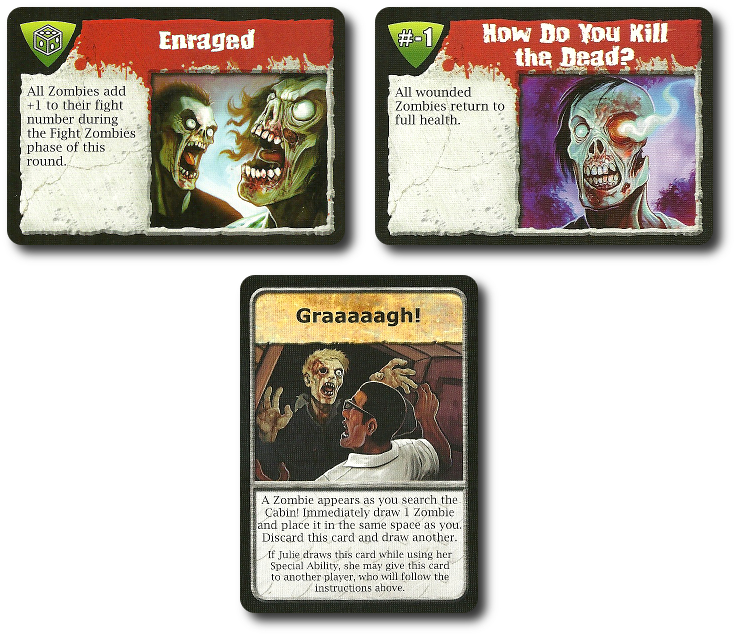
Hurry! Get to the Cabin!
To set up the game, first place the game board in the center of the playing area. All the players should be able to reach the game board easily whilst playing the game.
Second, construct the Cabin Walls and place them around the border that separate the cabin from the outside. A perimeter line is provided and easy to spot on the game board. The Cabin Walls can be placed anywhere on the line, but place the Cabin Wall piece with the door on the outside perimeter of the cabin’s living room (it’s the one with the broken TV, couch, and fireplace).
Third, have each player select their Character and take the corresponding Character pawn, matching Character board, and matching Character Zombie token. The Character board is placed in front of the player, human side up, and the Character pawn is placed inside of the cabin. Each player rolls 1 six-sided die to determine in which of the 6 rooms their Character starts in. Or, if you like, simply place them. The dice are meant to randomize starting location, but you won’t break the game if you place the Characters in the rooms without using the dice. The Character Zombie token is placed to one side of the game playing area and might be used later in the game. Any Character boards, pawns, and tokens not selected are returned to the game box.
Fourth, place all the Zombie tokens (NOT the Survivor tokens) into the Zombie draw bag. Randomly draw 6 Zombie tokens and place 1 Zombie token in each furthest section away from the cabin starting with arc 1. Make sure the corner with the highest number value is pointing towards the center of the game board and cabin. When completed, add the Survivor tokens to the Zombie draw bag. Place the bag to one side of the game playing area and within easy reach of all the players.
Fifth, shuffle the Event and Cabin cards separately. Place each deck, face-down, next to the game board. These are now the Event and the Cabin draw decks. Leave room next to each deck for a discard pile.
Sixth, place the Radio pieces, Rescuer token, Injury tokens, and Crack tokens to one side of the game playing area.
This completes the game set up. Have each player roll the die. The player who rolls the highest is the first player and receives the Bait token.
Here They Come…
Dead Panic is played in rounds with each player taking a turn in turn order sequence per round. A player’s turn and round is summarized here. For full details, refer to the game rules that are available from the game’s official website.
Note that some of the Characters have special abilities that break or bend the rules. Refer to the individual Character boards for full details.
Step 1: Perform Actions
Starting with the player who has the Bait token, each player will take 2 actions at this time. Players can perform the same action twice and the same actions as their team members. The possible actions include:
Draw 1 Cabin Card
For 1 action, the player can draw 1 Cabin card. The Cabin deck is full of things that will help the player and their team members survive. Only players inside the cabin area can draw a Cabin card. A player can hold no more than 5 Cabin cards at a time (one Character can hold up to 6 cards). Discarding Cabin cards is a free action, but players should think twice before discarding Cabin cards. Once the Cabin deck is depleted, it is not reshuffled. Any Cabin card that is discarded is lost for the duration of the game.
Use 1 Cabin Card
For 1 action, the player can use 1 Cabin card from their hand. The card they use can be the same one they just drew. When the player uses a Cabin card, they place it in front of them and will move it to the Cabin deck discard pile when it’s exhausted. Using weapons and items is described in further detail later in this review.
Move 1 Space
For 1 action, the player can move their Character pawn to any arc space that they are adjacent to. Character pawns cannot move diagonally. A player can pass through a Cabin Wall piece without penalty (thematically speaking, they are crawling through a window). When moving in the cabin, the Character pawns cannot pass through the center of the cabin, meaning they must go from room to room to get to the cabin’s other side.
Now might be a good time to quickly discuss the game board. The playing area is comprised of spaces and arcs. In total, there are 6 arcs and each arc has 4 spaces in it. The numbers are used when randomly determining entry points. Anything that is sharing the same space in an arc is considered in contact with each other, despite some of the spaces being very long. Lots of helpful summary information is included on the game board’s 4 corners for quick player reference.
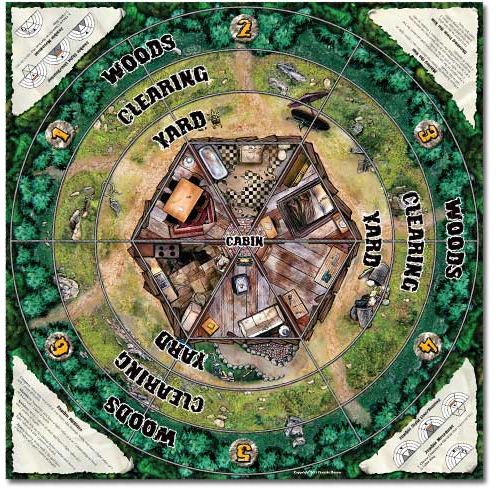
Characters that share the same space as a Survivor can move the Survivor with them. If the Character passes through a space with a Zombie token, they must immediately fight it or the strongest Zombie token currently occupying the same space. If they succeed, they can continue their movement.
Trade, Give, or Get 1 Card or Radio Piece
If a team member’s Character pawn is located in the same or adjacent space as the player’s Character pawn, the two individuals can exchange 1 Cabin card or 1 Radio piece for 1 action. Hand size limit must be maintained, but a player can discard a card for a free action. Any weapons or items previously played that are traded keep their level of ammo and are played in front of the new owner immediately.
Repair 1 Crack
For 1 action, the player can remove 1 Crack token from a Cabin Wall piece. The player’s Character pawn must be adjacent to the Cabin Wall piece (either inside or outside of the cabin area).
Collect 1 Radio Piece
The Survivors have individual pieces of a radio that can be assembled to call for help. For 1 action, a player can collect 1 Radio piece if their Character pawn is in the same space as a Survivor token. If the Survivor reaches the safety of the cabin, they drop a Radio piece that can be picked up for 1 action by a player. If the Survivor is killed by a zombie, they will drop the Radio piece where they fall. A single Survivor can only provide 1 Radio piece per game.
Assemble Radio
For 1 action, the player can assemble the Radio pieces if they have 2 or all 3 pieces. Once the Radio is fully assembled (with all 3 pieces), it can be used as a club and only takes 1 card slot in the player’s hand.
Call Rescuers
For 1 action, the player can call the Rescuers. This is only done once and can only be done once the Radio is completely built. When the Rescuers are called, a single six-sided die is rolled and the Rescuer token is placed in the furthest section away from the cabin that matches the number rolled on the die.
Move Van
If the Character pawn is located in the same space as the Rescuer token, it will take 1 action to move into the van. Once there, they are relatively safe and get a special attack action. They can also drive the van 1 space for 1 action in any direction other than moving diagonally. If none of the players are in the van, the player with the Radio can move the van 1 space left or right of its current position for 1 space. Moving a van into a space with Zombie tokens allows the player to inflict 1 point of damage on one zombie.
Step 2: Draw 1 Event Card
After all the players have had a chance to take 2 actions, the player who currently has the Bait token draws 1 Event card and reads it out loud. Event cards tell the players how many tokens to draw from the Zombie draw bag and any other actions that need to be taken. All Zombie tokens are placed on the furthest space away from the cabin area and will move forward during the course of the game. Where the Zombie token is placed is determined by rolling a single die and placing the Zombie token in the corresponding space. All Zombie tokens come onto the board with full health. Once the Event card has been resolved, it’s discarded. If the Event deck is ever depleted, reshuffle the discard pile to create a new Event deck
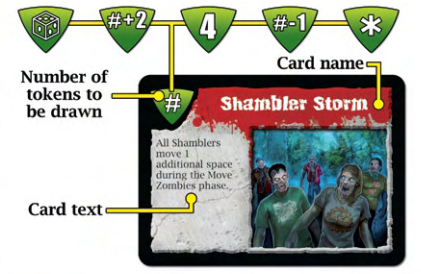
Step 3: Move Survivors and Zombies
After the Event card has been resolved and discarded, all the zombies get to move. Note that this zombie movement is in addition to any zombies who were moved as a result of an Event card. But before the zombies move, any Survivor tokens on the game board move 1 space towards the cabin. If a Survivor moves into a space with Zombie tokens (or a Zombie token moves into a space with a Survivor token), they will fight during the next step. After the Survivor tokens are moved, the Zombie tokens are moved.
When determining where a zombie moves, there are a few rules to follow.
- Zombies will never move if they share a space with a Character or a Survivor.
- Zombies will always move towards a Character or a Survivor if they can (Characters and Survivors must be within a zombie’s “sight line” which is defined as the spaces to the zombie’s right, left, back, and front).
- By default, a zombie will walk towards the center of the game board towards the cabin.
- Once inside the cabin, zombies will always advance towards the closest Character or Survivor, even if it means leaving the cabin.
- Zombies move sideways from one arc to another if they are chasing a Character or Survivor before they attempt to enter the same space.
- The Bait token will always draw a zombie if two or more Characters or Survivors share the same space.
Not all zombies move the same. Their current state of decay and type determines how fast they are. Zombie fans will be pleased to learn that both shambling and sprinting zombies are found in Dead Panic. Of course, that’s all kinds of bad news for the players and Survivors.
- Creepers move 1 space only on a die roll of 4 or more
- Sprinters always move 2 spaces
- Shamblers, Brawlers, and Brutes always move 1 space
When a Zombie token gets to the cabin, they will being to break through the walls. Zombies will hit the Cabin Wall piece during their movement or via an Event card. Most zombies will crack the wall with 1 hit and a few will breakdown the wall with one tremendously strong punch. Cracked Cabin Wall pieces receive a Crack token signifying it is damaged. These can be removed by a player for 1 action during their turn. If a zombie attacks a wall that already has a crack, the Cabin Wall is destroyed!
Step 4: Fight!
Combat in Dead Panic is very straight forward. Combat will occur if 1 or more Zombie tokens are sharing the same space as a Character or Survivor, but players can also attack zombies at a distance using ranged weapons.
Character Combat
Characters fight zombies (including Character Zombies) with guns or melee weapons. Melee weapons and ranged weapons do not last forever. Ammo is depleted and melee weapons will break. The weapon and items found in the Cabin deck are placed in front of the player and rotated to different number values to show how many more times it can be used. Some ranged weapons can be reloaded (the crossbow, for example), but that takes a turn to complete.

Ranged combat always wins against another zombie. The player shoots and the player hits, but only if the target zombie is within range. Melee combat is a gamble. The player rolls 2 six-sided dice and attempts to roll a number higher than the Zombie token fight value. When a Zombie takes damage, it’s token is rotated clockwise once for every damage it takes. The number value that is pointing towards the cabin is reduced as a result. If the rotation would reduce the value to zero or less, the Zombie is placed in a pile and will be returned to the Zombie draw bad only after the draw bag has been depleted. Zombies never truly die…
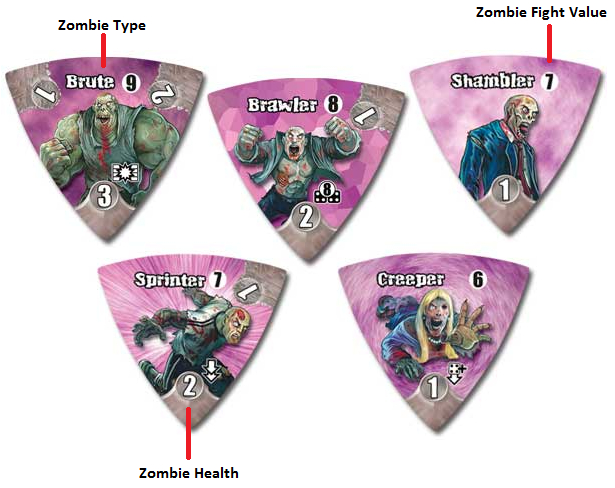
Ties result in a wash (the Character and the Zombie take zero damage) unless otherwise stated by a specific zombie type, but if the player fails the roll, their Character will suffer 1 Injury token or drop the weapon they fought with. The Injury token moves towards the skull space on the Character card when additional damage is dealt to the Character. Again, a Character will only take damage if they are fighting a zombie hand-to-hand. So, you know, don’t do that.
If a player is unlucky (or foolish) enough to get into combat without a weapon, they will not inflict damage, but they can push the zombie back in any direction the player likes.
Survivor Combat
Survivors have lasted as long as they have because they know how to fight and to run, but they are not terribly good at either. Not as good as the players, at any rate. When a Survivor attacks a zombie, the Survivor inflicts a number of points of damage equal to the Survivor’s current health. Unfortunately, the Survivor suffers a number of points of damage equal to the zombie’s current health, too. This happens simultaneously. Both the Zombie and the Survivor tokens are rotated as required.
Multiple Zombies and Multiple Characters
When more than 1 zombie shares the same space as a Survivor, the players determine how to distribute the damage among the tokens. Again, it’s all done simultaneously and the tokens will be adjusted accordingly.
If a Survivor and a Character share the same space while fighting, they join forces. The player decides where the Survivor focuses their attack and resolves it first. Then the player goes.
If two or more Characters are engaged in combat together, the Bait token determines which of the Characters go first. Players then take turns fighting the zombies. No zombie can be fought more than once per round.
Fighting from the Van
The first Character to jump in the van is the driver. Every Character after that who jumps in the van as a movement action can then fire from the van as long as they are not the driver. The Character need not have a weapon (the Rescuers came prepared) to fire upon a zombie. For 1 action, the player can fire at 1 Zombie token up to 3 spaces away from the van’s current space inflicting 1 point of damage. This can only be done once per turn, meaning a player could not fire twice from the van on their turn. The driver can also run into a Zombie token that occupies the same space as the van, inflicting 1 point of damage to 1 Zombie token of their choice.
Step 5: End of the Round and Passing the Bait
After all the combat has been completed, the round ends. The Bait token is passed to the next player in turn order sequence if that player is still a human. Otherwise, it goes to the next player in turn order sequence. Note that the Bait token is not always passed to a new player during this phase. A few Event cards will force the Bait token to change hands. If this happens, simply skip the Bait passing at this time.
On Being Dead’ish
If a Survivor falls, their token is flipped over and it is now a Survivor Zombie. If the Survivor has not yet given the Radio piece to a player, it drops is on the space now.

If a Character takes enough damage that the Injury token moves to the skull space, the Character pawn is tipped to its side until the next Zombie Movement step, signifying the Character has fallen. The player now flips their Character board to the zombie side and replaces their Character pawn with their Character Zombie token. Then the player takes 2 Injury tokens and places them next to 2 Character Zombie abilities. Character Zombies move 2 spaces and fight by rolling 2 six-sided dice, comparing the value against a human Character’s rolled fight value. A player who has been turned into a zombie can now win the game if they are able to stop the human Characters from escaping. Other Character Zombies are now their friends and the players should work together to eat their living friends. Ah, friendship…
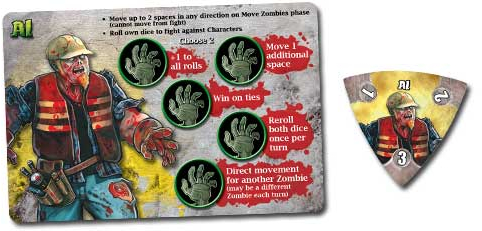
Surviving the Game
The game continues until every human Character has made it to the van or all the Characters have been overrun by the zombies.
Game Variants
Dead Panic comes with a few game variants that can be included to change the game play. They are summarized here.
- Zombie Overlord: By default, Dead Panic is a cooperative game. If the players agree, one of their members could take the role of the Zombie Overlord. The Zombie Overlord controls the zombies and plays the Event cards instead of them being randomly drawn. Combat is more complicated and the Characters will be up against some very smart zombies right from the start. The Zombie Overlord wins (with any players who have also turned into zombies) if all the Characters are overrun, but the living human players win if at least 1 Character escapes.
- Less Panic: This game variant includes several small rule changes that reduce the game’s overall level of difficult. This is a great way to introduce the game to new and inexperienced players who might find the standard game play a bit intense. Extra damage, early Survivors, player Bait selection, and sharpshooting skills are provided to all the players upfront.
- More Panic: This game variant makes the game more difficult by including penalties for failed rolls, introducing semi-cooperative game elements, endless zombies, and mercy kills when a Character falls, which allows the other players to ensure the Character doesn’t come back as the undead.
I have only summarized the game here. I didn’t go into greater detail regarding the cards and some of the more strategic and tactical moves a player can take. To learn more about Dead Panic and read the full rules, visit the game’s official website.
Prediction
Zombie games are typically filled with clichés and Dead Panic is no exception. Cabin in the woods? Mixed group of survivors? Zombies lurking in the shadows? I know I’ve seen movies that are built around this very same premise. And you know what? It works. It works really, really well. This type of theme and narrative feeds off our fears of being isolated, lost, and unable to receive help. You’re on your own and you have to depend on others who are also depending on you. Your odds of survival are slim, but the consequences for not trying are too horrific to even consider.
I love it.
I’m pretty burned out on Zombie games, to be honest. There are a few I love to play, but I find the majority of them to be unimaginative. What intrigues me about this game has nothing to do with the zombie theme. Dead Panic would appear to be an updated and more intense version of Castle Panic, a game designed and published by the same company. I very much like Castle Panic and play it often with my little geeks. Throwing zombies into the mix and making it a horror survival game has roused my interest.
But how will our other groups like it? For starters, I’m going to need to find some Parent Geeks and Child Geeks who can play the game together. I don’t personally find the game illustrations to be terribly horrific and I’m sure I can find a number of other Parent Geeks who think that same. The trick is going to pitch Dead Panic as a “family horror game”. That is not a game type you see much of. If I can get the Parent Geeks and the Child Geeks to sit down and play the game together, I predict they will both love it. As for the Gamer Geeks, I don’t see anything to suggest they will dislike Dead Panic. If I position it as a light zombie game with strategic cooperative play, that should be enough to get them to sit at the table and play it. I won’t be mentioning it’s like Castle Panic, however, because a number of our Gamer Geeks have come to dislike that title. Besides, I want them to play the game with an open mind with no preconceived assumptions. That’s the goal, at any rate.
Teaching Dead Panic is going to be very simple if your group members have played Castle Panic before, or any cooperative game. For those players who have not or are relatively inexperienced or young, you are going to have to put a bit more effort into it. But here’s the brilliant part about Dead Panic. It’s a game you can teach as you play. This is a cooperative game and that means everyone can help each other out. Players who cannot yet read can play the game with older players and non-gamers can have a much fun as Gamer Geeks. It’s all about the team in Dead Panic, and the more diverse your team, the better your game. Do read the rules a few times, though. They are a bit … well … fiddly. Not the strongest rule book I’ve ever read and there are some gaps that should be filled. Nothing game breaking, I assure you, and anything that is missing can be worked out through simple logical thinking.
After I showed the game to my three little geeks, they were super excited to give it a try. The suggested minimum age is 13-years-old, but I don’t see why my 4-year-old couldn’t participate. I’ll most likely use the game variants that drastically reduce the game’s level of difficulty, but there is nothing in Dead Panic that should cause him grief since his family can help him play. After I showed Dead Panic to my little geeks and explained how to play it, I asked them their thoughts on the game so far.
“REALLY, REALLY COOL!” ~ Liam (age 9)
“So this is Castle Panic but with zombies? Neat!” ~ Nyhus (age 6)
“We are on the same team, Daddy? Yeah!” ~ Ronan (age 4)
Looks like we’re all ready to work together and kick some zombie butt! Let’s play Dead Panic and see if it scares up a good time or it makes our brain hurt.
Final Word
Huzzah! I was able to play Dead Panic with enough Child Geeks to get a good sense of how well the game would be received and played by our younger little geeks. What I found was pure awesomeness. All the Child Geeks, be they as young as 4-years-old or as old as 15-years-old, understood how to play the game and played it well. Of course, the younger Child Geeks needed much more assistance, but they participated with the group and contributed. I’m prepared to suggest that Dead Panic is playable by Child Geeks as young as 9-years-old, but not younger. All the Child Geeks who were younger than 9 needed a great deal of help and the game ran a bit too long for them. While they had fun, most of the game direction was provided to them. In short, the older players did a lot of thinking for the younger players. The younger Child Geeks still had fun, though. According to on Child Geek, “This is a fun Zombie game, but I hate it when they rush at you!” All the Child Geeks voted to approve the game and wanted to play it again when it was put back in the box.
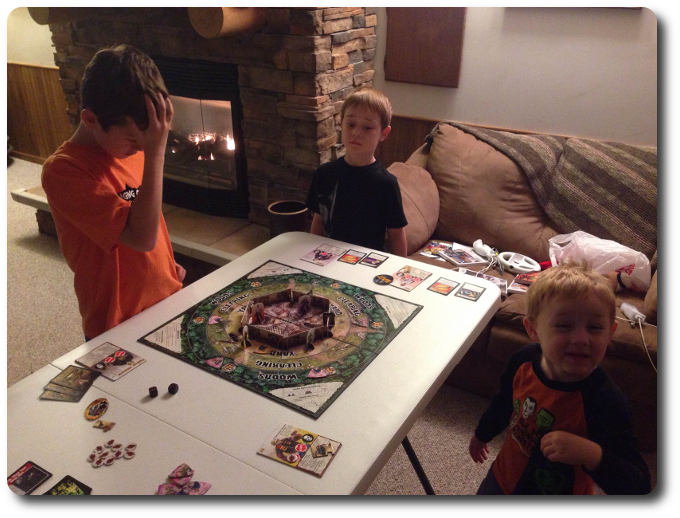
It’s my 4-year-old’s turn to draw a zombie! His older brothers are not optimistic…
The Parent Geeks were mixed when it came to the game. They enjoyed it with their family and with their peers, but the Parent Geeks who didn’t like Zombie games didn’t like Dead Panic. To which I think we can all agree is not a big surprise. So, instead of asking them if they thought it was a good Zombie game, I instead focused on their thoughts on how well the game played as a cooperative experience. On this point, all the Parent Geeks agreed the game did an excellent job. According to one Parent Geek, “This is a fun and light game with zombies. I’m not big into zombies, but I really enjoyed myself.” Another Parent Geek said, “This is a great Zombie game. It’s fast to play and easy to learn. I’d play this again without hesitation.” All the Parent Geeks, after much discussion, voted to approve the game. A number of the Parent Geeks wanted me to emphasis – again – that some of the artwork might be too creepy for children.
The Gamer Geeks thought Dead Panic was a lot of fun. According to one Gamer Geek, “This is a pretty interesting casual cooperative game. We’ve played more complicated Zombie games, but this one does everything right.” Another Gamer Geek was less impressed and said, “Yes, this is a good game, but it’s not the best Zombie game I’ve ever played. A lot of the choices are obvious.” Most of the Gamer Geeks found the standard game to be too easy, so we tried the Zombie Overlord and More Panic game variants. This elevated the game to new heights and was very well received by the Gamer Geeks. In the end, they all voted to approve the game.
Let’s get the obvious “How is this different from Castle Panic?” question out-of-the-way, first.
Both Castle Panic and Dead Panic share a number of common game mechanisms. The rotation of tokens, movement, and cooperative game play, for example. But that is where the similarities end. In truth, if you’ve played Castle Panic, you’ll be able to play Dead Panic almost instantly, but where the two games quickly diverge is the overall game play experience. In Castle Panic, the players cannot address specific enemies on a whim. That is not the case in Dead Panic. Players can range outside of the cabin and take the fight right to the zombies if they want, with or without a weapon in hand. They can even sacrifice themselves or act as bait. In fact, they have to if they want to improve their odds of winning. There is also player elimination which changes an individual player’s objectives during the game. A human player working for the betterment of all will quickly shift gears and focus on total destruction if they turn into a zombie.
Another big difference is the theme and narrative elements. Castle Panic’s theme is loosely based in a fantasy world, but players don’t have much interaction with the game’s overall narrative. Dead Panic is rich with theme and the narrative is upfront and in the players’ faces right from the start. This makes it a more engrossing and entertaining game, in my opinion. I feel like the story is being created in front of me and I am playing a major role in it. In Castle Panic, I just felt like I was focusing on risk management. In Dead Panic, I feel like a character in a cheesy low-budget horror film fighting to survive.
I really like Dead Panic. It’s light, it’s easy to set up, it’s easy to play, and it provides a very enjoyable cooperative game experience. And, yes, I am a fan Zombie games, which is certainly playing a part in my final thoughts on the game itself, but I would enjoy Dead Panic regardless. A game that provides as much as this one does deserves a play or two, no matter how you feel towards brain eating undead. Despite Dead Panic doing nothing to attempt to reinvent the Zombie game types and riddled with clichés, it delivers fun. Do sit down and try Dead Panic the first chance you get. I think you’ll be surprised how much fun you have running around the woods next to an abandoned cabin as you attempt to not get eaten.
This game was given to Father Geek as a review copy. Father Geek was not paid, bribed, wined, dined, or threatened in vain hopes of influencing this review. Such is the statuesque and legendary integrity of Father Geek.




Pingback: Dead Panic Gets Geek Father’s Seal of Approval! « Fireside Games | News
Pingback: Castle Panic: Big Box Game Review - Father Geek